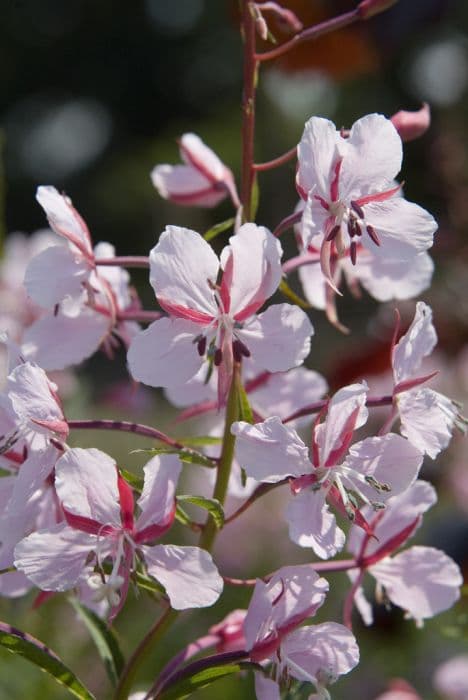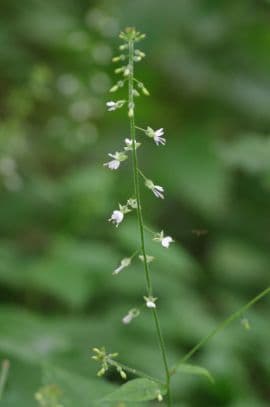Elegant Clarkia Clarkia unguiculata 'Appleblossom'

ABOUT
The Clarkia unguiculata 'Appleblossom', often known as the 'Appleblossom Clarkia', exhibits a delicate and ornamental appearance. The plant is famed for its floral display, which features a range of soft pink shades, evoking the gentle hues of apple blossoms in spring. The flowers are typically composed of four rounded petals that can sometimes show subtle variations in color intensity, creating a gradient effect. Another striking characteristic is the prominent display of stamens and pistils in the center of the flowers, which often contrast with the petal colors, lending the blooms an intricate and eye-catching look. The leaves of the 'Appleblossom Clarkia' are narrow and lance-shaped, with a bright green color that provides a lovely backdrop to the flowers. They are usually arranged alternately along the stems, adding to the plant's overall feathery texture. As this description specifically avoids mentioning the dimensions of the plant, it's important to focus on the plant's overall form, which is typically upright and branching, creating a bushy and lush silhouette that adds to its charm in garden settings or when used as a cut flower in arrangements.
About this plant
 Names
NamesFamily
Onagraceae
Synonyms
Elegant Clarkia, Mountain Garland, Clarkia
Common names
Clarkia elegans 'Appleblossom', Godetia unguiculata 'Appleblossom', Godetia elegans 'Appleblossom'.
 Toxicity
ToxicityTo humans
Clarkia unguiculata 'Appleblossom', commonly known as Elegant Clarkia, is not commonly known to be toxic to humans. There is limited information regarding its toxicity, as it is primarily grown for ornamental purposes. However, as with any plant, individual sensitivities can vary, and it is generally not advised to ingest parts of ornamental plants due to the potential for allergic reactions or gastrointestinal distress.
To pets
Elegant Clarkia is also not widely recognized as being toxic to pets. Most sources do not list it as a plant that is harmful to dogs, cats, or other domestic animals if ingested. Nonetheless, pet owners should always exercise caution with ornamental plants, as they may cause mild stomach upset or an allergic reaction in some pets if they consume the plant. Always monitor pets around plants and contact a veterinarian if any unusual symptoms occur after ingestion.
 Characteristics
CharacteristicsLife cycle
Annuals
Foliage type
Deciduous
Color of leaves
Green
Flower color
Pink
Height
1-3 feet (0.3-0.9 meters)
Spread
1 foot (0.3 meters)
Plant type
Herb
Hardiness zones
9
Native area
California
Benefits
 General Benefits
General Benefits- Enhances Garden Aesthetics: Clarkia unguiculata 'Appleblossom' adds soft pastel tones to garden spaces with its delicate pink and white blossoms.
- Attracts Pollinators: The flowers attract bees, butterflies, and other pollinating insects, supporting local ecosystems.
- Easy to Grow: This plant is known for being easy to care for, thriving in a variety of conditions and often growing successfully from seed.
- Drought-Tolerant: Once established, it has moderate drought tolerance, making it suitable for low-water gardens.
- Seasonal Interest: Blooming in late spring to early summer, it provides visual interest during these seasons.
- Makes Great Cut Flowers: The flowers have a long vase life, making them ideal for fresh bouquets and arrangements.
- Self-Seeding: It can self-seed under the right conditions, potentially reducing the need for replanting each year.
 Medical Properties
Medical PropertiesThis plant is not used for medical purposes.
 Air-purifying Qualities
Air-purifying QualitiesThis plant is not specifically known for air purifying qualities.
 Other Uses
Other Uses- Edible Flowers: The flowers of Clarkia unguiculata 'Appleblossom', also known as Satin Flower, can be used as a colorful garnish in salads or as an edible decoration on cakes and desserts.
- Craft Dye: The petals can be processed to create natural dyes for fabrics or paper crafts, offering a range of soft, earthy tones.
- Photography Prop: With their delicate appearance, Satin Flowers are often used as subjects or backdrops in floral photography.
- Art Inspiration: The flowers can serve as a model for drawings, paintings, and other visual art forms due to their unique shape and color.
- Education: Used in botany classes or nature educational programs to study the life cycle of flowers and plant biology.
- Sachets and Potpourri: Dried Satin Flower petals can be included in sachets or potpourri mixes for a natural, subtle fragrance.
- Biodegradable Confetti: Dried petals of the Satin Flower can be used as eco-friendly confetti for outdoor celebrations.
- Livestock Forage: In certain settings, the plant may be used as a forage option, though it's not commonly known or widespread.
- Green Roofing: Satin Flowers may be utilized in green roofing projects where lightweight, low-growing plants are needed.
- Collectibles: Enthusiasts of heirloom seeds or unique plant species may cultivate Satin Flowers as part of their collection.
Interesting Facts
 Feng Shui
Feng ShuiThe Clarkia is not used in Feng Shui practice.
 Zodiac Sign Compitability
Zodiac Sign CompitabilityThe Clarkia is not used in astrology practice.
 Plant Symbolism
Plant Symbolism- Beauty: Named after William Clark of the Lewis and Clark expedition, the Clarkia unguiculata 'Appleblossom' is often associated with natural beauty, as it has delicate pink and white flowers that are reminiscent of apple blossoms.
- Resilience: This plant, also known as farewell-to-spring, often symbolizes resilience as it blooms in late spring to early summer, representing nature's tenaciousness before the onset of the harsh conditions of summer.
- Farewell or Departure: The farewell-to-spring's common name implies a sense of parting or conclusion, often making it emblematic of farewells or the end of a phase or period.
- Adaptability: As a plant that is able to thrive in a variety of conditions, farewell-to-spring can represent adaptability and the ability to adjust to changing environments.
- Delicateness: The fine, gentle petals of the flower may symbolize sensitivity and gentleness, resonating with the soft, delicate appearance of its blooms.
 Water
WaterThe Appleblossom Clarkia prefers moderate watering, being a relatively drought-tolerant plant once established. For young plants, maintain a regular watering schedule of about 1 inch of water per week, either by rainfall or supplemental irrigation. In the absence of precipitation, water your Clarkias twice weekly, providing approximately half a gallon per square foot of soil each time. Reduce the frequency to once a week or less as the plant matures and be mindful of rainfall to prevent overwatering. Ensure the soil is well-draining to avoid soggy conditions that can lead to root rot.
 Light
LightAppleblossom Clarkia thrives in full sunlight, meaning it should receive at least 6 to 8 hours of direct sun daily. The ideal spot for this plant is in an area that is exposed to the unfiltered sun throughout most of the day. While it can tolerate some light shade, especially in hotter climates, the best flowering results are achieved with ample sunlight.
 Temperature
TemperatureAppleblossom Clarkia does best in temperate conditions and can survive minimum temperatures down to 20 degrees Fahrenheit, but ideally, they should be grown where it does not drop below freezing. The maximum temperature tolerance can go up to 85 degrees Fahrenheit, with the optimal growth range being between 60 to 75 degrees Fahrenheit. It can be damaged by frost, so provide protection if temperatures are expected to fall near or below the freezing mark.
 Pruning
PruningPruning Appleblossom Clarkia is mainly done to encourage bushier growth and to remove spent flowers, a process known as deadheading. Lightly prune the plants after the initial flush of flowers to promote a second bloom. The best time for pruning is in late winter or early spring before new growth begins. An annual trim is typically sufficient, though deadheading can be done throughout the flowering season as needed.
 Cleaning
CleaningAs needed
 Soil
SoilThe ideal soil mix for Farewell-to-Spring (Clarkia amoena) is well-draining and fertile, with a pH range between 6.0 and 7.5. A combination of loamy soil, peat or compost, and a small amount of sand provides the right texture and nutrients for optimal growth.
 Repotting
RepottingFarewell-to-Spring does not typically require repotting as it is an annual plant; it completes its life cycle in one year and then dies. Sow seeds in fresh soil each season for a new batch of flowers.
 Humidity & Misting
Humidity & MistingFarewell-to-Spring thrives in average humidity conditions. It does not require any special humidity adjustments, making it well-suited to the typical outdoor environment.
 Suitable locations
Suitable locationsIndoor
Ensure bright light, moderate watering, and good air flow for growth.
Outdoor
Plant in well-drained soil, full sun to part shade, moderate water.
Hardiness zone
9-11 USDA
 Life cycle
Life cycleClarkia unguiculata 'Appleblossom', commonly known as Elegant Clarkia or Mountain Garland, begins its life as a seed that germinates in late winter or early spring when soil temperatures and moisture levels become favorable. The seedling emerges and develops into a rosette of leaves at the soil surface, where it undergoes vegetative growth, establishing a root system and foliage. As the plant matures, it elongates and produces a flowering stem, with buds that develop into distinctive pink or white 'appleblossom' flowers typically in late spring or early summer. After pollination, which is often assisted by insects, the flowers produce seed capsules containing numerous seeds. These seeds are eventually dispersed by wind or other means and enter a period of dormancy, waiting for the next season to sprout. The parent plant completes its life cycle by dying back after seed dispersal, having spent its resources on reproduction.
 Propogation
PropogationPropogation time
Early Spring
The Clarkia unguiculata 'Appleblossom', commonly known as elegant clarkia, is most effectively propagated by seed. The best time to sow seeds is in early spring, directly into the ground where they are to grow. The seeds should be scattered lightly over well-drained soil and covered with a thin layer, about 1/8 inch (approximately 3 mm) of additional soil. It's important to keep the soil moist until germination, which typically occurs within 7 to 14 days depending on soil temperature and conditions. Elegant clarkia does not require special treatment to the seeds before planting, as they naturally germinate without any stratification or scarification. Once established, the plants may self-seed in subsequent seasons, thereby providing an effortless continuation of growth.









